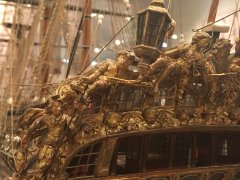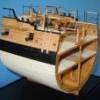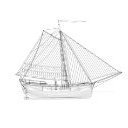-
Posts
13,093 -
Joined
-
Last visited
Reputation Activity
-
 druxey reacted to Valeriy V in Libertad 1925 by Valeriy V - Scale 1:100 - Spanish Type F Light Cruiser
druxey reacted to Valeriy V in Libertad 1925 by Valeriy V - Scale 1:100 - Spanish Type F Light Cruiser
General view of the cruisers hull with side keels.
-
 druxey reacted to Valeriy V in Libertad 1925 by Valeriy V - Scale 1:100 - Spanish Type F Light Cruiser
druxey reacted to Valeriy V in Libertad 1925 by Valeriy V - Scale 1:100 - Spanish Type F Light Cruiser
Screw steering device, but without screws.
-
 druxey reacted to Valeriy V in Libertad 1925 by Valeriy V - Scale 1:100 - Spanish Type F Light Cruiser
druxey reacted to Valeriy V in Libertad 1925 by Valeriy V - Scale 1:100 - Spanish Type F Light Cruiser
Parts before installation on the hull.
-
 druxey reacted to Valeriy V in Libertad 1925 by Valeriy V - Scale 1:100 - Spanish Type F Light Cruiser
druxey reacted to Valeriy V in Libertad 1925 by Valeriy V - Scale 1:100 - Spanish Type F Light Cruiser
The propeller shaft brackets are assembled.
-
 druxey reacted to Valeriy V in Libertad 1925 by Valeriy V - Scale 1:100 - Spanish Type F Light Cruiser
druxey reacted to Valeriy V in Libertad 1925 by Valeriy V - Scale 1:100 - Spanish Type F Light Cruiser
Brazing of propeller shaft brackets.
-
 druxey reacted to Valeriy V in Libertad 1925 by Valeriy V - Scale 1:100 - Spanish Type F Light Cruiser
druxey reacted to Valeriy V in Libertad 1925 by Valeriy V - Scale 1:100 - Spanish Type F Light Cruiser
Now we need to install the ship's propeller steering device.
Marking the directions of the propeller shaft lines.
-
 druxey reacted to empathry in FULMINANT by HAIIAPHNK - French stern castle
druxey reacted to empathry in FULMINANT by HAIIAPHNK - French stern castle
The original drawing of the Unicorn, imagined by Gérard Liger-Belair for his friend Hergé.
-
 druxey reacted to HAIIAPHNK in FULMINANT by HAIIAPHNK - French stern castle
druxey reacted to HAIIAPHNK in FULMINANT by HAIIAPHNK - French stern castle
Thank you.
Yes, the vertical positioning of the model has its advantages. First of all, it saves a lot of space. I adapted an ordinary clothes rack for such a vertical slipway. It was left by my son after he moved to a separate apartment and his room became a testing ground for me, where I do my modeling now. For a classic horizontal slipway I have to look for a lot more space. When I work with the stern in this condition I have the opportunity to put my wrists on the hull and so my hands are not on the weight, which is also very convenient. But as in many situations and here too along with pluses there are also minuses. For example, the vertical positioning of the ship breaks the correct perception. I have noticed several times that the eye gets used to this view, but when you turn the model in the correct position, it turns out that you made mistakes somewhere. Well and as it is a rack for clothes on it weighs and different clothes. And my heavy bags with camera equipment are stacked at the bottom. All this is needed as ballast, so that a heavy model does not topple the whole rack. It doesn't interfere with the work in any way, but when shooting, you can see fabrics or things in the background. And it makes the shots a bit dirty. And here is more than enough and shambles, which is visible on my table. Those are the downsides.
-
 druxey got a reaction from daHeld73 in HMS Bellona 1760 by SJSoane - Scale 1:64 - English 74-gun - as designed
druxey got a reaction from daHeld73 in HMS Bellona 1760 by SJSoane - Scale 1:64 - English 74-gun - as designed
I've had success by placing the plank, finished edge down, on the workbench. One end is against a bench stop. While I operate the miniature plane with one hand, I stabilize the plank with the other. The final surface is finessed using a sanding stick.
-
 druxey got a reaction from daHeld73 in HMS Bellona 1760 by SJSoane - Scale 1:64 - English 74-gun - as designed
druxey got a reaction from daHeld73 in HMS Bellona 1760 by SJSoane - Scale 1:64 - English 74-gun - as designed
An interesting approach. I like the tape idea. However, would using a miniature plane to cut the second edge down work for you instead of sawing it?
-
 druxey got a reaction from daHeld73 in HMS Bellona 1760 by SJSoane - Scale 1:64 - English 74-gun - as designed
druxey got a reaction from daHeld73 in HMS Bellona 1760 by SJSoane - Scale 1:64 - English 74-gun - as designed
It's surprising how many 'ah ha' moments occur as one works on the actual model. "Oh, so that's why they did it this way!" Lovely work, as always, Mark. Happy New Year to you.
-
 druxey got a reaction from daHeld73 in HMS Bellona 1760 by SJSoane - Scale 1:64 - English 74-gun - as designed
druxey got a reaction from daHeld73 in HMS Bellona 1760 by SJSoane - Scale 1:64 - English 74-gun - as designed
Aren't those pieces of plank an interesting challenge, Mark? Makes a nice change from boring, parallel pieces! Lovely job you're doing.
-
 druxey got a reaction from HAIIAPHNK in FULMINANT by HAIIAPHNK - French stern castle
druxey got a reaction from HAIIAPHNK in FULMINANT by HAIIAPHNK - French stern castle
Very nicely reworked. Having only the stern of the model is very convenient for tipping it up on end to work on! Papierverschwunden!
-
 druxey got a reaction from dvm27 in L'Amarante by marsalv - 1:36 - POF
druxey got a reaction from dvm27 in L'Amarante by marsalv - 1:36 - POF
The amazing floating beams! That is a neat solution for positioning them.
-
 druxey got a reaction from chris watton in L'Amarante by marsalv - 1:36 - POF
druxey got a reaction from chris watton in L'Amarante by marsalv - 1:36 - POF
The amazing floating beams! That is a neat solution for positioning them.
-
 druxey got a reaction from Keith Black in FULMINANT by HAIIAPHNK - French stern castle
druxey got a reaction from Keith Black in FULMINANT by HAIIAPHNK - French stern castle
Very nicely reworked. Having only the stern of the model is very convenient for tipping it up on end to work on! Papierverschwunden!
-
 druxey reacted to Baker in Mary Rose by Baker - scale 1/50 - "Your Noblest Shippe"
druxey reacted to Baker in Mary Rose by Baker - scale 1/50 - "Your Noblest Shippe"
After a long break, we started again on Mary.
The fore castle is painted, but the upper part was not really successful I thought. Too high and too green.
So the height was adjusted.
And repainted.
Better, I think.
Time to start on the 2 cannons in the fore castle. With special thanks to @henrythestaffy for the 3D printed cannons,much appreciated.
(The brass cannons upper left are fore the Brandenburger yacht)
there will be little to see of the carriages. So spend i little time on the details.
Make wheels
Use the crosscut saw to saw thin pieces. so that you can then knock out wheels across the grain.
The barrels will be glued on later.
A stair on both the sides is too much
Then the stair to the upper deck must be in the middle. And that is just before the entrance (arrow).
So from the lower deck a staircase on the starboard side. And to the upper deck a staircase on the port side.
The error in the planking will be invissible later
-
 druxey reacted to HAIIAPHNK in FULMINANT by HAIIAPHNK - French stern castle
druxey reacted to HAIIAPHNK in FULMINANT by HAIIAPHNK - French stern castle
Chapter 15
This chapter, by all the rules of the genre, should have featured a serenade, a passionate lover with a lute, and a shy lady behind a curtain. But none of them will make an appearance. And honestly, that’s for the best.
After finishing the windows, it was time to focus on the balcony. Finally, I removed something that had been hanging around on the model for way too long. A little backstory: when I built the balcony floor ages ago, I reinforced it with temporary braces and ribs to keep it safe from accidental damage. Back then, I made the temporary structure out of stiff paper.
Now, I’m not sure if there’s a similar expression in English, but in Russian folklore, there’s a saying: “Nothing is more permanent than something temporary.” And this project proved it true yet again. When I crafted those paper supports, I thought they’d only be there for a day or two. It was supposed to be a quick fix until I could replace them with something sturdier made of wood or plywood. But time passed. The paper structure held up remarkably well—nothing tore, nothing collapsed. So I kept postponing the replacement, thinking, “Eh, it works for now.”
Still, it always felt a little embarrassing when those paper supports showed up in photos. I mean, this is a big, elegant ship model. Paper details? Even temporary ones? Come on. I’d cringe at the sight and promise myself, “Tomorrow, I’ll fix this. At least for the sake of the photos.” But tomorrow never came.
So here we are—finally tearing off that paper. It felt like the start of a new era for this model. No more weird paper braces in the pictures! Honestly, it’s worth celebrating. A holiday, even! But what should I call it? Cartondance? LiberPapira? Maybe something fancy like Papirôle with a French twist? I’ll have to think about it.
Of course, as soon as I removed one temporary fix, I started building another. This time from different materials.
I know, it looks just as primitive and pathetic. But hey, it gets the job done. This new contraption was necessary to bend the balcony railings into the correct radius.
And gradually, the outlines of the balcony began to take shape. After working on the windows, it was an immense pleasure to cut regular wooden planks for the paneling instead of slicing thin strips of wood as delicate as noodles.
Little by little, the balcony started to take shape. After working on the windows, it was such a relief to stop cutting delicate strips for the rain spouts and switch to crafting regular planks for the cladding.
When building ship models, we all face countless decisions: what details to prioritize, what to simplify, and what to ignore. These dilemmas come in many forms. For instance, should you leave a small gap between parts? You could fix it by crafting a new piece, but that takes extra time. Or maybe a strip of wood ends up slightly too short—should you cut a new one or just leave it, knowing the gap will later be hidden under additional layers?
You’ll also encounter the opposite situation. Sometimes you meticulously detail an interior cabin, knowing full well that no one will ever see it once the model is complete. Yet, you do it anyway—for the satisfaction of knowing it’s there.
It’s always a balancing act: where to cut corners and where to go all out, even if no one else will notice. There’s no right answer. Each modeler decides for themselves. That’s what makes this a hobby—it’s about doing what brings you joy.
Why am I spending time writing about such a seemingly trivial topic? Because I want to leave behind a record of this little piece of Fulminant that will never be seen. Maybe I’ll forget about it someday, but at least here, it’s preserved. For example, I carefully crafted the interior cladding of the balcony—complete with supports and wooden planks—just as it should be.
Now, I’m making everything the way it should be on a proper model. No paper. Everything is serious and meticulously crafted. After all, it’s LiberPapira and Papirôle! Life, however, just smirked at me and said, “No paper, you say? Sure, keep dreaming. I’ll wait for tomorrow.”
And tomorrow came...
Chances are, I’ll end up photographing more temporary fixes—maybe even made of paper—and worrying about how they look. So much for Cartondance!
But in the meantime, progress continues. Rough drafts and sketches are giving way to permanent details—at least the first layer of them. Eventually, these will be built upon with additional layers and finer details.
Going forward, I won’t stray off-topic with stories or jokes about placing a young lady on the balcony and a lovestruck suitor below. Nor will I describe the following photos in detail. Instead, here are just a few images.
That’s pretty much it. Over these last few posts, I’ve briefly described what’s been happening over the past few months. Believe me, even these long-winded posts barely scratch the surface. I could tell so many more stories—some of them worthy of a full comedy script, filled with misunderstandings, mishaps, and unexpected twists.
Some of those stories have already reached their conclusion, while others are still unfolding, and I have no idea how they’ll end. But that’s a topic for another time.
For now, I’ve shared the latest updates. As you can see from the photos, even the finished parts aren’t truly final yet. That’s what I’m working on now.
At every step, I find myself wondering: Did I make the right choice? Does this solution work, or did I mess up? Does the model resemble the drawings? How do I balance Berain’s designs with the actual construction and my own vision?
These are the questions on my mind, and I’ll address them in the next post.
-
 druxey reacted to thibaultron in Fractal vise on kickstarter
druxey reacted to thibaultron in Fractal vise on kickstarter
Looking at the video, I'd say about 1" round object.
-
 druxey got a reaction from No Idea in L'Amarante by marsalv - 1:36 - POF
druxey got a reaction from No Idea in L'Amarante by marsalv - 1:36 - POF
The amazing floating beams! That is a neat solution for positioning them.
-
 druxey got a reaction from Ilhan Gokcay in Loreley 1884 by Ilhan Gokcay - 1/75 - Scale Steam Yacht
druxey got a reaction from Ilhan Gokcay in Loreley 1884 by Ilhan Gokcay - 1/75 - Scale Steam Yacht
Wow! Beautifully done.
-
 druxey got a reaction from Keith Black in Loreley 1884 by Ilhan Gokcay - 1/75 - Scale Steam Yacht
druxey got a reaction from Keith Black in Loreley 1884 by Ilhan Gokcay - 1/75 - Scale Steam Yacht
Wow! Beautifully done.
-
 druxey reacted to Kenchington in Lanyards and Ratlines
druxey reacted to Kenchington in Lanyards and Ratlines
The really messy job is tarring the shrouds and I've never done that. (The nearest I came to it was tramping around one of Kruzenshtern's capstans to hoist a Russian cadet who had been lowered too far down the rigging he was tarring. Happier times.)
But the mess on your hands when going aloft also comes from the shrouds because you should never, ever hold the ratlines. They have a very nasty habit of breaking at just the wrong moment, when a firm grip on the shroud will save you from embarrassment. One did fail on me, the very first time I went aloft (on a dubiously authorized climb, at age 13) and I have not needed to be told again.
Trevor
-

-
 druxey got a reaction from Kenchington in Lanyards and Ratlines
druxey got a reaction from Kenchington in Lanyards and Ratlines
First, it is considered standing rigging and therefore was tarred to preserve it. Secondly, sailors got this on them when they climbed the rigging, hence the traditional name 'tars'. I'm sure Trevor could confirm that!










